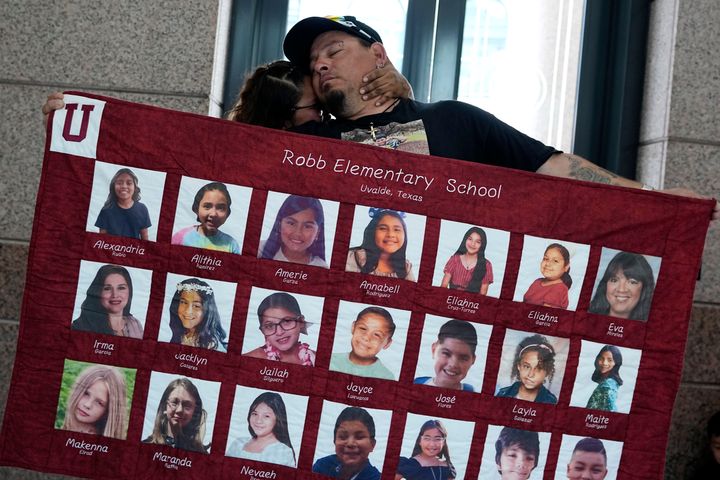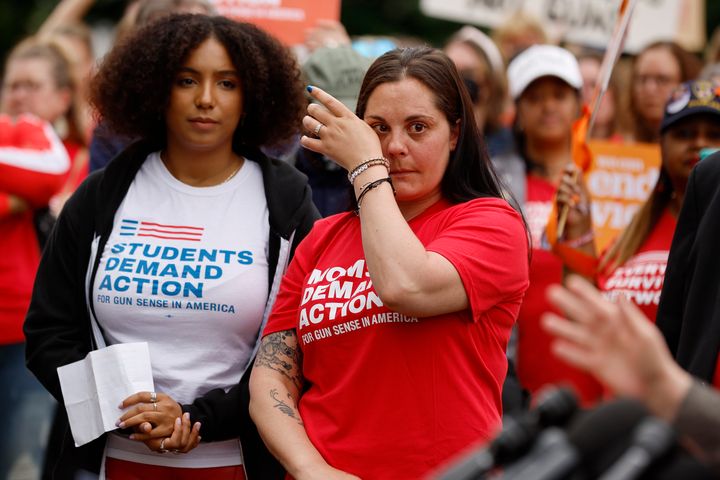The Washington Post made the decision on Thursday to publish a project about mass shootings that includes devastatingly graphic photos and videos from the scenes ― a rare move by the media as American society continues to grapple with the ethics behind sharing traumatizing content for the purpose of fighting the country’s unending gun violence epidemic.
The project, “Terror on Repeat,” examines the increasing popularity of AR-15 rifles ― a relatively easy-to-operate, accessible weapon of war ― and its gruesome but significant role in America’s deadliest massacres. Gunmen have used AR-15s to fire hundreds of bullets within minutes, killing large numbers of people of all ages.
As part of the project, the Post published very personal accounts with extremely graphic content of several high-profile mass shootings that have occurred in the U.S. over the past decade. The move is rare for a media outlet, as crime scene photos are often kept hidden by courts, and newsrooms typically avoid publishing available photos out of respect for victims and families.
“The goal was to balance two crucial objectives: to advance the public’s understanding of mass killers’ increasing use of this readily available weapon, which was originally designed for war, while being sensitive to victims’ families and communities directly affected by AR-15 shootings,” Executive Editor Sally Buzbee wrote in the Post’s explanation for its decision.
“In the end, we decided that there is public value in illuminating the profound and repeated devastation left by tragedies that are often covered as isolated news events but rarely considered as part of a broader pattern of violence.”
The project can be found here, though both the Post and HuffPost warn that the photos and videos can be extremely graphic and upsetting.

The content included photos, videos and quotes from the high-profile mass shootings at Robb Elementary School in Uvalde, Texas; at First Baptist Church in Sutherland Springs, Texas; at Marjory Stoneman Douglas High School in Parkland, Florida; at the Route 91 Harvest festival in Las Vegas; at Sandy Hook Elementary School in Newtown, Connecticut; at the Tree of Life synagogue in Pittsburgh; at Allen Premium Outlets in Allen, Texas; at Century 16 movie theater in Aurora, Colorado; at Old National Bank in Louisville; and in the Oregon Historic District in Dayton, Ohio.
“One of my cousins ― the cops dragged him in the hallway when they were taking us out,” elementary school student Jaydien Canizales told the Post for the project. “I saw the bullet in his head.”
Similarly to the Post, HuffPost has previously reported on the shockingly dangerous speed of automatic and semiautomatic weapons, a gunshot’s severe medical impact on the victim’s body, and on the question of whether media and loved ones of victims should share the graphic content to sway public opinion.
Despite years of efforts by gun control advocates and gun safety lobbying groups to pass legislative measures that would reduce the bloodbath, lawmakers have yet to pass substantial measures to ban civilian access to AR-15s.
As of Thursday, there have been more than 600 mass shootings in the U.S., according to the Gun Violence Archive, which defines the term as based on four or more people shot or killed, not including the shooter.
The slow rate of progress despite bipartisan support for tighter gun control policies has led to a public debate about whether releasing graphic images of such massacres ― especially those with child victims ― would help the cause by showing the reality, or if it would simply retraumatize survivors and families.
According to Buzbee, reporters and editors on the project participated in training by the Dart Center for Journalism and Trauma before they viewed graphic content from the shootings, so they can incorporate best practices for viewing and potentially publishing upsetting photos.
Reporters and editors also carried discussions about the merits of publishing such content, speaking with advocates and victims’ families. Some families saw potential in publishing such content for public awareness, while others saw the decision as dehumanizing and unnecessarily traumatizing.

In 2012, Sandy Hook Elementary School principal Dawn Lafferty was one of 26 people killed in the mass shooting. When a horrifyingly similar massacre erupted a decade later in Uvalde, gun control advocates and journalists reached out to daughter Erica Lafferty to potentially share traumatizing photos of the Sandy Hook shooting in hopes of swaying public opinion about gun safety in America.
“STOP ASKING ME FOR AUTOPSY PHOTOS,” Lafferty tweeted in a now-deleted May 2022 post. “The audacity of those who are asking and demanding Sandy Hook crime scene photos to be released is unfathomable. I envy those who don’t and can’t understand the weight of this ask.”
Buzbee said the Post established “one ground rule” before reporting for the project.
“If we sought to publish any pictures of identifiable bodies, we would seek permission from the families of the victims,” Buzbee said. “Some families indicated they would be open to granting permission, but ultimately we decided that the potential harm to victims’ families outweighed any potential journalistic value of showing recognizable bodies.”

